RETI 2.0 Plenary Session
By Laura Cunningham

^Future scenario planning map showing possible renewable energy commercial interest areas and potential Transmission Assessment Focus Areas (TAFAs) in California.
January 3, 2017 - The Renewable Energy Transmission Initiative 2.0 process is a high-level planning, non-regulatory, "what if" scenario to get California to its statewide intermediate target to reduce greenhouse gas emissions 40 percent below 1990 levels by 2030, mandated by Governor Brown. We support this target but believe that we need much more rooftop solar plus battery storage, advanced Distributed Energy Resources, microgrids, energy efficiency, and better policies that support local renewable energy instead of more utility-scale renewable energy on natural habitats.
During a webinar held by the RETI team today (California Energy Commission, California Public Utility Commission, and California Independent System Operator, we learned about the big picture and challenges of moving California into a higher-integration of renewable energy. The Golden State has been so good at building renewable energy that it now has an oversupply of utility-scale solar in summer peak hours, and stresses on the grid to ramp up when the sun goes down and demand peaks. The best wind resource areas in-state are built-out and congested now, and the best future wind areas are either near Mt. Lassen in the northeast state, or far away in Wyoming-Colorado-New Mexico Plains areas. Even the valuable hydroelectric Northwest connection is filled to capacity with the California-Oregon Intertie line no longer open to new generation.
High-voltage and lower voltage transmission line stretching across the state and out into the Western US remain an expensive and controversial necessity for continuing to build the renewable energy portfolio in this scenario. We think the better alternative is to unleash the potential of local energy and rooftop solar.
^Sunrise Powerlink and Southwest Powerlink at Jamul, eastern San Diego County.
Comment
Please ask for:
--A high energy-efficiency future, which would require much less desert solar projects and large transmission lines.
--Increase net-metering and consider feed-in-tariffs to allow more people to obtain rooftop solar. Request that advanced DERs be given much more analysis in high-level planning.
--Use advanced transmission technology on existing transmission lines, such as advanced conductors that would be able to increase the electricity carried, before building new transmission lines.
--Ask that RETI make public the planning process for environmental, cultural, and land use implications for the 50% RPS planning process, and that the DG alternative would have much less impacts to deserts, viewsheds, and cultural and biological resources.
--Ask that the Riverside East Solar Energy Zone, Imperial Valley solar Development Focus Areas, Victorville-Barstow area, and West Mojave/Antelope Valley/Tehachapi area not be used for further renewable energy development due to unacceptable impacts to culturally significant landscapes, local communities, and biological resources.
--Request that the Lassen County wildlands full of sagebrush plains, volcanic mountains, and pronghorn antelope herds not be used for utility-scale renewable energy or new transmission corridors.
Comment here (deadline January 10, 2017): https://efiling.energy.ca.gov/Ecomment/Ecomment.aspx?docketnumber=15-RETI-02
Future Planning to Increase Renewable Energy Has Constraints
The value of utility-scale photovoltaic solar projects is going to steeply decrease, according to the RETI planners, as an oversupply problem fast looming in the next few years. See the "Duck Curve" problem. In response, planners want to ramp up wind energy after 2020 and through the year 2030, to help balance the grid with energy that is generated more at night or other times than solar. That will, however, create curtailment costs, when wind projects may need to shut down during periods when too much energy is supplied, or environmental impacts are too great (bird kills).
The wind energy areas in Imperial Valley and Chuckwalla Valley are poor or have too many environmental constraints, according to the RETI planners.
It was admitted that the Riverside East Solar Energy Zone was a challenging location to build out the theoretical 4,000 more megawatts desired by the state to reach its goals, because of culturally significant landscapes valued by Tribes.
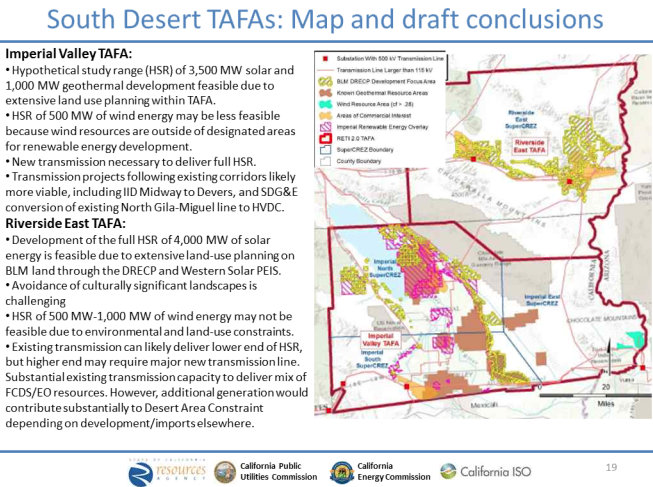
The Baja California Norte Intertie is fully subscribed, and wind energy in Baja is constrained getting to the San Diego load center. There is regional congestion in the Imperial Valley now and would require a new large transmission line between the ECO Substation on the western Imperial County line west into San Diego County to the Miguel Substation, paralleling the unpopular Sunrise Powerlink or Southwest Powerlink. Or a new line would need to go from northwest Imperial County to Coachella Valley. Both transmission lines would run up against environmental and land use permitting issues, it was admitted.
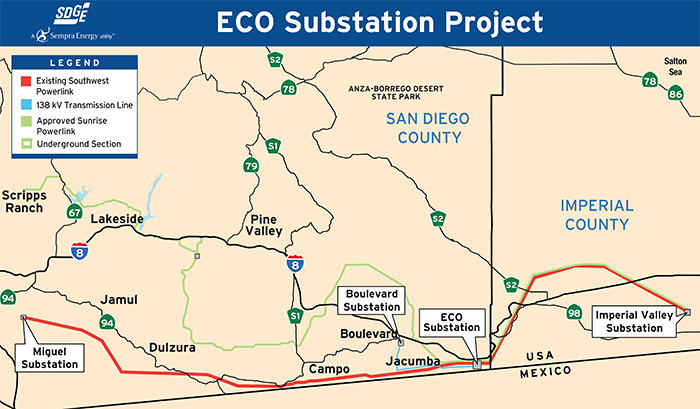
RETI 2.0 planners suggest to reach the 50% RPS California would have to build a new third transmission line across the San Diego backcountry. Unless more rooftop solar and local battery storage is allowed to be built.
^500 kiloVolt transmission lines: Sunrise Powerlink and Southwest Powerlink in eastern San Diego County. Do we need more of these?
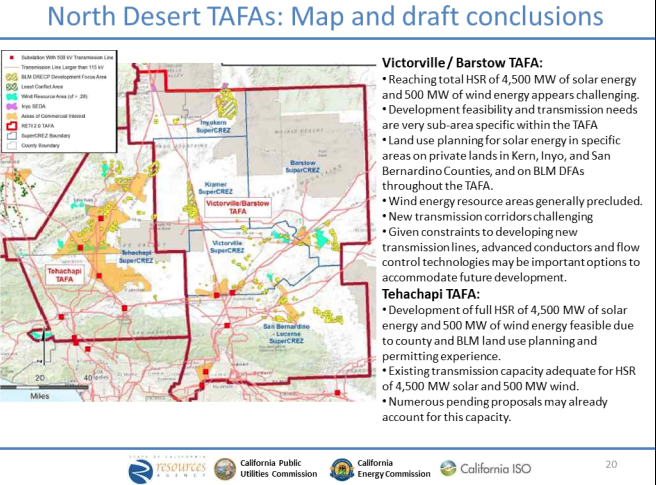
The yellow solid shapes are "Areas of Commercial Interest" as determined by the California Energy Commission. We note the public had no input on this, nor was there any mapping of public areas of interest, local community quality of life, or Tribal culturally significant landscapes. Proposed transmission lines here, such as the Coolwater-Lugo proposal, have been met with resistance from local groups.
The Desert Area Constraint in the grid affects a vast area in southern California. The Eldorado to Lugo corridor may need a new transmission line to prevent congestion with proposed imports of wind energy from Wyoming and Colorado (as much as 7,500 MW), and any new utility-scale solar projects in the region (another 1,000 MW). This would mean another transmission line through the Soda Mountain, an area environmentalists worked to protect next to the Mojave National Preserve. A Mira Loma-Red Bluff line might be needed as well or as an alternative, cutting south through the Mojave Desert. Both these transmission projects would be "complex and expensive," say the RETI planners.
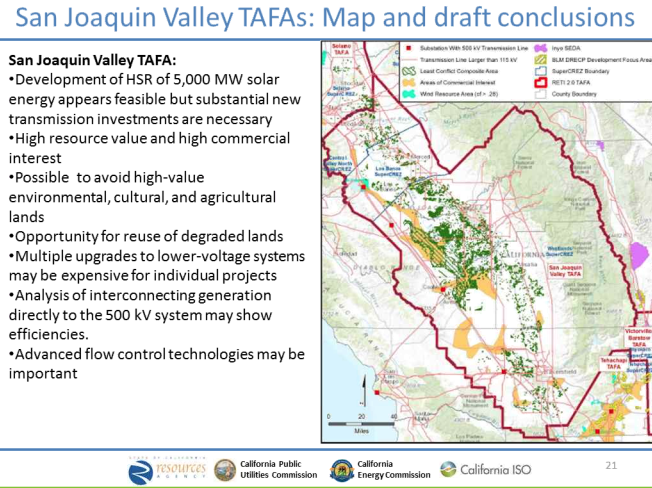
The San Joaquin Valley has commercial interest for solar, and plenty of open capacity on 500 kV transmission lines. But new transmission would be needed on lower voltage transmission, or solar projects could be aggregated close to the 500 kV line. Advanced load controls could also play a role. We would support utility-scale solar projects in this region on degraded agricultural lands that do not have enough water supply to support current agriculture--there are many almond orchards that have had to be torn down due to lack of water irrigation supply in the northwest part of the valley. But we do not support new solar projects on natural communities of the San Joaquin Valley, which support arid saltbush communities, native grasslands and wildflower fields, and endemic species such as San Joaquin antelope ground squirrel and blunt-nosed leopard lizard.
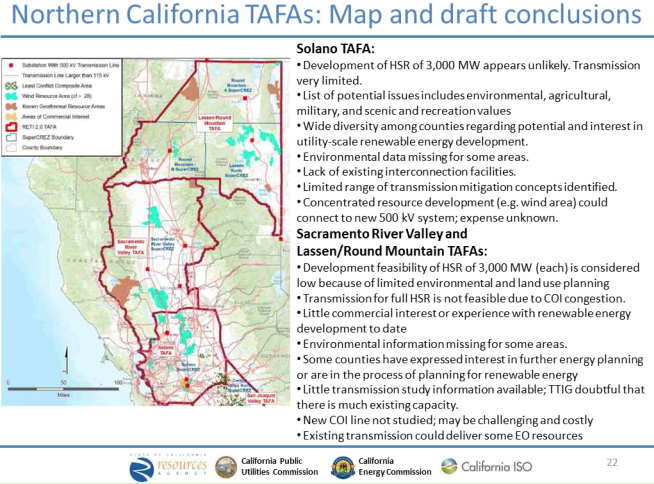
There are many wind resource areas in Lassen County in northeast California, but there is limited existing transmission, as well as environmental and scenic constraints (such as Lassen Volcanic National Park). Environmental resource information is missing for this area, there has been no planning for renewable energy.
The California-Oregon Intertie (COI) is filled, so there would be obstacles to getting any Reno to Alturas lines into California load centers via this route. Nevada geothermal resources remained trapped from California by this obstacle and the Sierra Nevada.
Therefore, if new transmission were built in western transmission expansion scenarios for 2030 goals, the California solar peak oversupply could export to the Southwest, but this presents problems with similar peak for Arizona solar. The Northwest is a good option to import and export, except in the spring when hydroelectric power is in oversupply. But as discussed, the RETI planners see large permitting and expense problems to doing this.
The final report for RETI 2.o will be delivered January 31, 2017.
See more on RETI 2.0 on our page: Non-Transmission Alternative: DRECP Is Outdated
RETI 2.0 Workshop
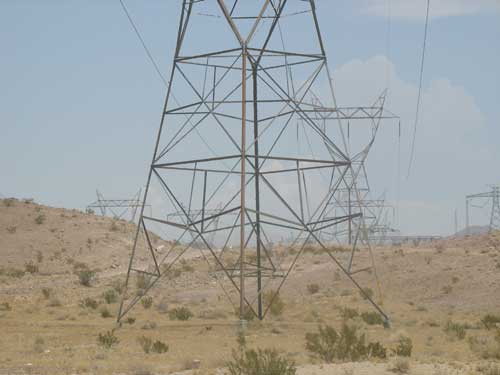
September 13, 2015 - Sacramento CA - On September 10 we participated in a workshop put on by the Renewable Energy Transmission Initiative team about RETI 2.0. Documents can be found >>here. Comments are due September 24, 2015. Because California often leads the way in renewable energy planning and law, we avidly follow such proceedings. We support clean energy in the built environment (rooftop solar and energy efficiency especially), and not as large-scale renewable energy projects on desert ecosystems requiring long expensive transmission lines.
The workshop is early in the process, the very beginning, of developing a new transmission plan for California, based on planning done years ago for the original RETI (which developed in part into the Desert Renewable Energy Conservation Plan (DRECP).
Several topics were discussed, such as looking at cloud cover patterns to spread out large-scale solar projects across the landscape in sunnier locations. Reliability was a huge issue, and the question of how storage could be integrated.
The California Public Utilities Commission asked: when coal plants are shut down, how will this work? Will the state move to natural gas storage? And transmission to bring in generation from long distances away from load centers?
Utilities commented there may have to be a mix of natural gas power plants and renewable energy.
California Energy Commission (CEC) Commissioner Karen Douglas said energy efficiency would be important as well. AB 758 was approved to be implemented by the CEC, raising the energy efficiency of building.
The team mentioned that throwing electric cars into the mix would complicate the picture, and meant reliability of the grid was even more crucial.
The bar for transmission goes up with increased renewable energy and a 50% Renewable Portfolio Standard in California. The team must work with the Cal Independent System Operator. Taking full advantage of "low hanging fruit" would be needed (such as energy efficiency).
Tribal Consultation
A representative of the Dry Creek Rancheria commented that they had been involved in the RETI 1 discussions and requested that Native American heritage be involved as it was then, that tribal government consultation be undertaken. She said some tribes wanted to develop renewable energy on their lands but had no access to transmission, so it was not feasible. Commissioner Douglas assured her that all tribes in California were notified of this planning process
Utilities Speak Up
A rep from the Imperial Irrigation District (IID) voiced his support for RETI, saying how Imperial County is poised to use its "almost unlimited capacity" to develop solar, wind, geothermal, and biomass power but cooperation was needed to build transmission lines to expert the renewable energy to cities.
The IID is the third largest public utility in California, an independent balancing authority. It is the largest irrigation district in the nation. It also has the highest unemployment rate with a poverty level of 23-25% (California's is 16% in general). The air in the county is very unhealthful (although this is in part due to agricultural particulates, scraping of desert soils, and pollution from across the border in Mexico). So IID says it has hope RETI will increase jobs and increase air quality.
Pacific Gas & Electric (PG&E) spoke about how it looks to RETI 2 to inform the transmission planning process in the next few years. They said to look carefully at existing transmission that is available, as in the San Joaquin Valley. They warned including out-of-state generation would result in expensive new transmission lines. "Transmission is not a free lunch." So they advised maximizing existing transmission to optimize costs [to the ratepayer].
Wind and Solar Energy Associations
The California Wind Energy Association spoke up about needing to identify the backbone transmission lines and look at upgrades, as the Desert Renewable Energy Conservation Plan (DRECP) is fast leading to wind prohibition zones in the best areas.
The Large-scale Solar Energy Association supported RETI 2 transmission planning for their future developments.
Environmental Groups
Barbara Boyle representing the Sierra Club made a comments about emphasizing resource protection as a co-equal goal along with renewable energy development. She discussed the California Energy Commission's Energy Calculator which has a goal of 20,000 MW of renewable energy from the desert. Right now, 11,000 MW have been built or are underway. That leaves 9,000 MW to go to meet 2040 goals, and she said much of that should come from energy efficiency and distributed generation (DG) instead of all utility-scale energy. She also said to keep in mind the impacts from importing generation from other states.
Steve Mills of The Alliance for Desert Preservation told the RETI team to look at the distributed generation strategic plan and move away from centralized utility-scale projects. RETI should be used to move towards creative thinking, not reactive, and the RPS could be met by expanding rooftop solar, microgrids, and new storage. According to the CEC, there is 5,471 MW of small solar DG online in the state, with another 1000 MW pending. This could be doubled with energy efficiency savings. Los Angeles has 19,000 MW of rooftop solar potential. he called for RETI to shift to a DG model. he reminded the team about the Public Utilities Commission (PUC) asking whether new transmission was for the public good? The Coolwater-Lugo Transmission Project was rejected by the PUC because it was not in the public benefit they determined. Will RETI overshadow this? Basin & Range Watch agrees with this comment.
Kim Delfino of Defenders of Wildlife commented that RETI needs to also incorporate benefits to species and wildlife. there needs to be proper siting of projects, and better planning during RETI to avoid resource conflicts that we've seen in the last few years. It is important to have environmental modeling and data, she said. She said her group was very interested in participating in the process. County governments should be brought in to the process more.
Laura Crane of The Nature Conservancy said there needs to be clear goals: protection of nature and biodiversity should be an implicit goal. "Smart from the start." Scenario-based analysis looking at landscapes, and a stakeholder process, should be used.
Bay Area Municipal Transmission Group (BAMx) commented that existing transmission can integrate a lot more renewable energy than planners think.
Commissioner Wrap-up
CEC Commissioner Robert Weisenmiller concluded the workshop by saying there is a need to plan robustly for the long term, and not just be concerned so much with cost right now. "We build it, they will come," referring to new transmission lines. He especially emphasized that reliability of the grid was crucial, so new renewable energy generation would be beneficial if it could integrate storage and peaker plant-type storage at that. [This to us means the Palen CSP plant would get a boost to approval, since Abengoa is seeking to make it a peaker storage solar power plant.]
HOME.....Non-Transmission Alternative: DRECP Is Outdated....Transmission
